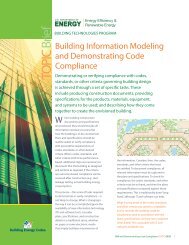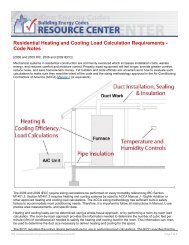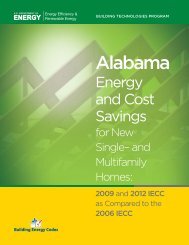Shaping the Energy Efficiency in New Buildings - Building Energy ...
Shaping the Energy Efficiency in New Buildings - Building Energy ...
Shaping the Energy Efficiency in New Buildings - Building Energy ...
You also want an ePaper? Increase the reach of your titles
YUMPU automatically turns print PDFs into web optimized ePapers that Google loves.
<strong>the</strong>re are also certa<strong>in</strong> mandatory requirements that must be met regardless of anyalternative options. The approach to build<strong>in</strong>g performance varies between APPcountries. The United States employs an energy/cost/budget method, which is anenergy cost-based type of build<strong>in</strong>g performance that differs from o<strong>the</strong>r energyconsumption-based build<strong>in</strong>g performance approaches. Japan and South Korea employ a scor<strong>in</strong>g or po<strong>in</strong>t approach, which fallssomewhere between a trade-off and performance approach. In Japan’scommercial code, each section of <strong>the</strong> code is scored separately, mak<strong>in</strong>g it moreak<strong>in</strong> to <strong>the</strong> trade-off alternatives <strong>in</strong> countries with prescriptive requirements.Japan’s commercial and residential codes both also have performancerequirements based on energy consumption per square meter. In South Korea, all<strong>the</strong> requirements <strong>in</strong> <strong>the</strong> build<strong>in</strong>g energy code are scored toge<strong>the</strong>r, mak<strong>in</strong>g it morelike a performance approach. South Korea also has prescriptive <strong>in</strong>sulationrequirements <strong>in</strong> its general build<strong>in</strong>g code. Ch<strong>in</strong>a has adopted a hybrid approach: first, <strong>the</strong> build<strong>in</strong>g performance approach isused to determ<strong>in</strong>e <strong>the</strong> difference <strong>in</strong> energy consumption between a designed and areference build<strong>in</strong>g, <strong>the</strong>n <strong>the</strong> difference is adjusted us<strong>in</strong>g <strong>the</strong> trade-off approach.Australia lists two types of build<strong>in</strong>g performance approaches for build<strong>in</strong>gs. For dwell<strong>in</strong>gs,<strong>the</strong> <strong>the</strong>rmal calculation method is employed to comply with <strong>the</strong> Australian Build<strong>in</strong>gCodes Board’s Protocol for House <strong>Energy</strong> Rat<strong>in</strong>g Software. Each dwell<strong>in</strong>g unit has anenergy rat<strong>in</strong>g of not less than 3 stars. For commercial build<strong>in</strong>gs, <strong>the</strong> codes set maximumregional annual energy allowances (<strong>in</strong> megajoules per square meter) by fuel and build<strong>in</strong>gtypes, with a separate section devoted to <strong>the</strong> methodology to calculate annual energyconsumption. There are also provisions for trade-offs and a build<strong>in</strong>g performanceapproach for houses.Ch<strong>in</strong>a’s commercial build<strong>in</strong>g energy codes comb<strong>in</strong>e <strong>the</strong> performance approach and tradeoffapproach. First, annual energy consumption is calculated and compared for heat<strong>in</strong>gand cool<strong>in</strong>g of a reference and designed build<strong>in</strong>g. Second, <strong>the</strong> trade-off approach is usedonly if <strong>the</strong> value of a designed build<strong>in</strong>g is higher than <strong>the</strong> reference case. A similarcomb<strong>in</strong>ation approach also applies for residential build<strong>in</strong>g codes.Japan’s and South Korea’s build<strong>in</strong>g energy codes for commercial build<strong>in</strong>gs adopt ascor<strong>in</strong>g approach: <strong>the</strong> desired measures that lead to higher build<strong>in</strong>g energy efficiency arescored with higher po<strong>in</strong>ts. Differ<strong>in</strong>g from its commercial build<strong>in</strong>g energy codes, Japan’sresidential build<strong>in</strong>g energy codes have prescriptive measures <strong>in</strong>stead of scored ones,though with both <strong>the</strong> residential and commercial codes <strong>in</strong> Japan, <strong>the</strong>re are performancebasedmetrics as well.South Korea has a recommended build<strong>in</strong>g energy efficiency rat<strong>in</strong>g system based on <strong>the</strong>performance approach. However, <strong>in</strong> some areas such as new towns, municipalgovernments may require that <strong>the</strong>ir new build<strong>in</strong>gs obta<strong>in</strong> a higher level label for energyefficiency than specified <strong>in</strong> <strong>the</strong> build<strong>in</strong>g code. In addition, South Korea is prepar<strong>in</strong>g anew performance-based code which sets requirements for maximum annual energy usage.Accord<strong>in</strong>gly, after 2010, build<strong>in</strong>gs over 10,000 square meters will be required to submitannual energy consumption and a CO 2 emission report to <strong>the</strong> government. Thesedocuments must be calculated by <strong>the</strong> performance approach.55
















